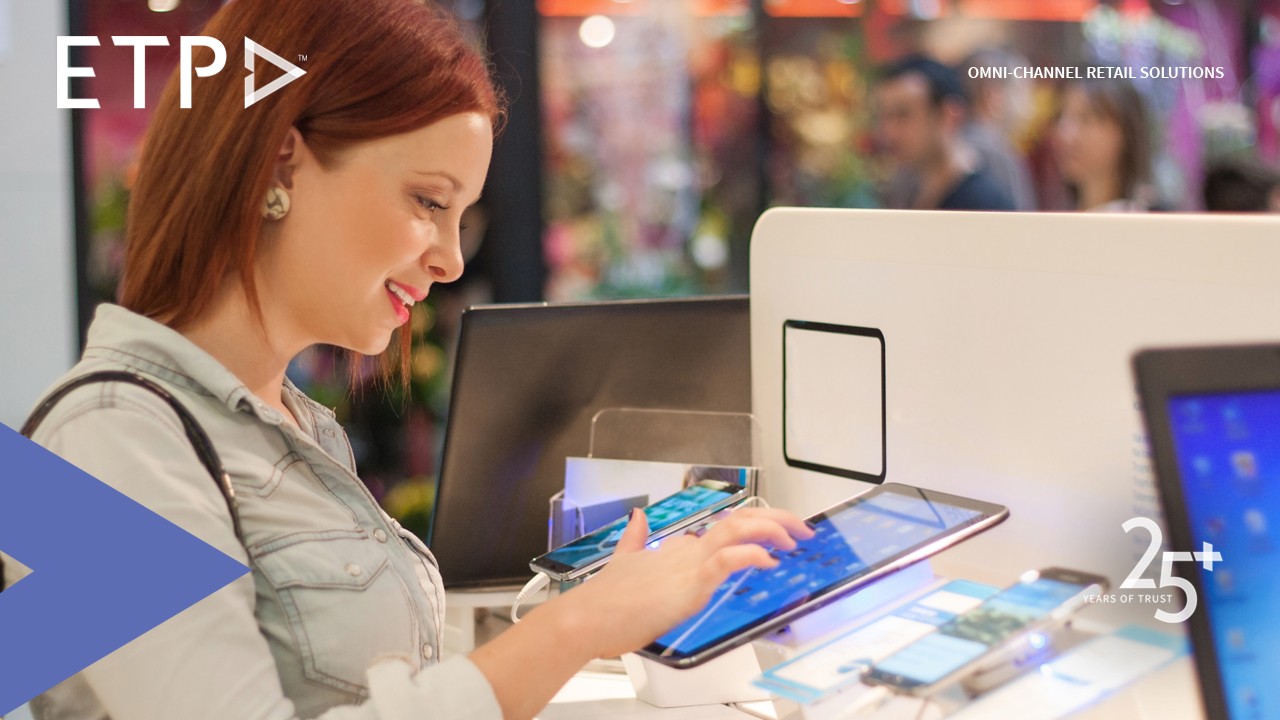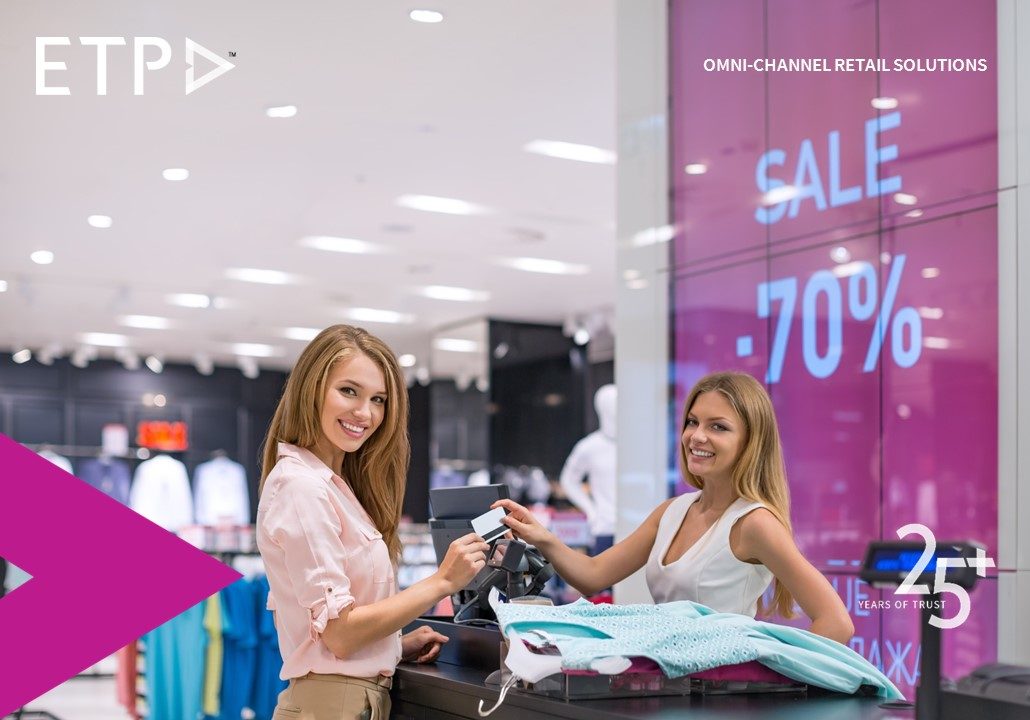Some intriguing insight into the benefits for retailers of investing in in-store digital technology and seamless shopping experiences.

Some intriguing insight into the benefits for retailers of investing in in-store digital technology and seamless shopping experiences.


It is time for retailers striving to be customer-centric to reconsider the role of their brick-and-mortar stores and in-store sales associates in-order to support the modern age context, immediacy, personalization, and information. The entire shopping journey experience needs to be seamless and a singular process where both the offline and online shopping must be extensions of each other. The concept “endless aisle” is one way of addressing this, where retailers place tablet kiosks at the end of aisles so shoppers can research and purchase products as they would do using their computers or mobile devices. This allows the consumers to access and order from a full catalog of available inventory, even those that are unavailable at the store.
Enabling a seamless, unified omni-channel experience must also extend to shopper interactions with store associates and customer service both online and in person. As shoppers expect store associates to be knowledgeable and informed, this translated to the need of associates’ ability to sell and assist the shoppers both online and offline. For example, store associates must know how to place an order and ship it to the customer if an item is out of stock in the store. And they must know how to check the online order status for a customer in the store.
Being cognizant of the fact that 37% of shoppers end up purchasing additional items when they are shopping for products in stores, a sales associate with accurate, updated information and history of each shopper can boost conversions, thus increasing the top line and helping retailers reduce markdowns on unsold inventory, both of which leads to higher revenues.
The execution of this process depends on aggregating omni-channel data and employing advanced analytics tools on the aggregated data to derive information about every shopper that can be used by the store staff. It mandates that retailers break down channel and department silos, align goals across channels, and encourage and incentivize employees to deliver on the omni-channel promise.
Also, giving shoppers visibility into the inventory can go a long way as customers expect not only to be able to view inventory available in-store and on the website but also the inventory number to be accurate real-time. The retailer’s challenge therefore is to display the inventory accurately including unit inaccuracy, shrinkage, and sales that day.
Needless to say, adopting new fulfillment methods and commerce approaches, including buy-online-pick-up-in-store (BOPIS), ship from store, buy-online-return-to-store, and save the sale, to name a few, is necessary. If an item is not available at a store, shoppers will be pleased when presented with a choice such as shipping from another store. Or shipping from the nearest store, when they are shopping online. The upside of taking an order online and shipping items from stores is the ability to lower in-stock inventory, decrease shipping costs and offer customers faster shipping. But achieving this goal requires solid planning and mapping stores to the online warehouse, which is only possible when leveraging fully integrated systems that offer cross-channel capabilities.
The right Order Management System can help companies make intelligent fulfillment decisions and streamline orders across channels to better serve customers while optimizing the use of inventory and reducing fulfillment costs for optimizing profits. Previously, inventory planning and replenishment were siloed: the sale began and ended in store (or online). Now the lines are blurred: the sale might start online but inventory might come from a physical store.
It goes without saying that an effective omni-channel environment is built upon integrated systems, departments and channels, with measurements and compensation that are aligned to support an omni-channel strategy and approach.
All of these changes require buy-in and leadership from the retail executive team. This team has to set the tone and expectation on service and training, focusing on all aspects of sales along with all customer touch points and their interconnectedness. And it all hinges upon ‘omni-channel’ being woven into the fabric of the retail organization.

In spite of all their efforts, why do so many retailers do not get it right in executing an effective customer-centric strategy? The reason is – in umpteen cases, retail brands are strongly focusing their efforts on selling their products instead of concentrating on equipping their business for delivering experiences that address the needs of the shoppers while harnessing their buying intent. In order to create and deliver the right omni-channel experience that is fulfilling, retailers and brands must think beyond their products – rather they must think ‘customers’. Customers are at the center when it comes to omni-channel retailing and this is evident in the traits that omni channel retail businesses need to focus on.
Some Of The Essential Traits Of Omni-Channel Retail Are:
One of the proven ways to ensure satisfaction of today’s consumer expectations and increase brand loyalty is by creating online communities where like minded shoppers can seek and share advice on products, and immerse themselves in a unique brand experience.
More retailers are tapping into the power of user-generated content to open new avenues for connecting with their consumers. One case in point would be the example of a successful footwear and accessories company which post the launch of their website in 2014, brought the social media activities of its customers to the fore by enabling the site to pull in images from Facebook, Instagram, and Twitter tagged with the brand name and feature them on the homepage. Shoppers were also encouraged to upload their own photos showing how they incorporate the brand’s footwear and accessories into their wardrobe. This managed to generate a positive buzz among the customers to see their pictures showcased on the brand’s official website, enhancing brand visibility and loyalty.
Also Read: Omni-Channel Technology Solutions For Your Retail Business


Retailers will be able to deliver the ultimate customer experience across all retail touch points every time, when they are able to have a single view of their customers, irrespective of the channels. For this, retailers will have to stop focusing on the channels and instead start concentrating on how to deliver the right omni-channel experience to every individual customer. They will need to stop treating online stores and physical stores as two separate entities. If the marketing communication and messaging are not consistent or personalized across all channels, the shopping experience will also be fragmented and suboptimal.
Delivering a superior, personalized omni-channel experience pivots upon merging the information retail owners get from online/mobile with the in-store customer behavior. As a preemptive measure, retailers must take cognizance of the fact that omni-channel shoppers switch between channels at will and choose whatever is most convenient and effective at that instant. It is at this juncture that retailers need to get their act right by making that experience feel cohesive while making sure that the messaging is consistent and personalized at every touch point. This demands a unification of customer interactions across all retail channels, which banks upon having a single unified view of the customer.
To be able to gain that single view of the customer, retail businesses must be capable of assimilating all the data available at their disposal, which includes shoppers’ online behavior and browsing history, in-store and online purchases, preferred products and modes of payment, to name a few. Since this data has to be derived from multiple sources, it is essential that retail businesses be equipped with fully integrated retail management systems. Also, they need to tap into the power of advanced analytics to make sense of the enormous amount of information coming through the systems and unify it so they can deliver the personalized brand experiences that today’s customers expect.
With the help of the unified data, retail companies can offer personalized shopping experiences with content that is targeted and tailored for the individual customer and is not channel based. Armed with this knowledge about the customer along with intelligent CRM integrated point of sale (POS) systems that display shopper profiles, in-store sales associates can recommend products, suggest relevant cross-sells, and even save the sale if an item is out of stock at that time. Similarly, online stores can offer recommendations to shoppers while they are researching or purchasing to aid them in their decision making and drive them to make the purchase and sometimes achieve up-sells. Hence, engaging in a consistent, personalized way across all channels will help retail businesses achieve omni-channel success.
Also Read: 5 Fundamental Benefits Of Going Omni-Channel

New age shoppers are connected, digitally savvy, always-on and at will, switch between channels while shopping. They expect retail brands to understand them better. After all, they are well aware that retailers these days are capable of capturing data – from customer details to how, when, what and where they make their purchases, and also what they are researching online. In other words, customers know that retailers can use the data to formulate an idea of their interests and motivators for purchase. As a result, customers’ expectations have gone beyond mere transactions. However, retailers today are falling short when it comes to satisfying consumer expectations for personalized, relevant shopping experiences.
While 69% of companies said they offer a superior online experience, 51% customers left a company that failed them online. Further, 81% companies said that they have or are close to having a holistic view of their customers, only 37% of consumers agreed to the fact that their preferred retail brand actually understands them. These statistics clearly highlight the gap between customer expectations and retail businesses’ understanding and execution.
How can retailers start to offer a seamless customer experience across channels and rise above the customer expectations?
In order to successfully implement seamless and personalized omni-channel shopping experiences, retailers require a single 360 degree view of their customer. Simply put, retailers need to have comprehensive information about their customers – their details, buying behavior, preferred channels, and so on. Not only this, the data should be handy with retail organizations to proactively plan and implement relevant offers and communications. This is possible only when the brand becomes truly customer-centric and leverages the information gathered to understand their omni-channel customer better.
By investing in the right omni-channel retail technology, retail businesses and brands have abundant opportunities to know their customers and engage with them, no matter which channel the customers prefer.
Also Read: How Can Retail Leverage The Benefits Of Blockchain


Christmas and New Year are just around the corner and shopping during this time of the year is at its peak. Amongst the festive shopping chaos, retailers and shoppers need to get their act right so that they do not miss out on anything – the maximum margins for retailers, and the right products for shoppers.
While shoppers – they are the ones who are connected – have the power of choice, the option of using multiple channels and alternatives through intense competition amongst brands. At this juncture, shoppers only know one thing, to get what they want, and they would not hesitate to switch between channels or for that matter even between brands, to do that. It is at this juncture that retail businesses can seize the opportunity to make their mark on the customers and step ahead of their competition.
Here’s how:
Connecting all the way – Gone are the days when the transaction marked the end of the sale and engagements were limited to product queries and purchases. Today, when customer expectations have reached new heights, better customer interaction is one of the necessities for retail owners to take cognizance of. They need to constantly engage with their customers, right from the product research stage till the next purchase, and it does not end there. Some benefits of connected retailing would be nurturing brand-customer relationships, enhancing customer loyalty, knowing the customers purchase history better and tailoring offerings to the customer’s tastes.
Choice is bliss – It should be the top prerogative of the retail businesses to add to the festive cheers by offering customers ample choices – be it products, prices, channels, promotions, and so on. Having said that, retailers should not overwhelm their customers with choices such that they are unable to make a decision. Rather, they should help their customers in choosing the right product that would be the best fit for the customers’ needs. Having the required quantity of merchandise and inventory, appropriate pricing of products, relevant and attractive promotions, and cross-channel operations are some of the necessary measures retailers need to take for providing a better and choicest shopping experience.
Creating the ho, ho, ho omni-channel experience – Retail businesses need to go omni-channel as it is the new norm and there are no two ways about it. If a customer would like to research for a product online, purchase the product in the store and expects it to be delivered at home, the retailer needs to manage the whole process seamlessly and satisfy the customer’s expectation. This would delight the customer since they are being offered a unified and seamless experience throughout their shopping journey regardless of the channel they choose to interact with. Investing in the right omni-channel retail solutions will allow retailers to spread the festive joy through superior customer experience and ring in more sales.
To make the Christmas shopping season truly merry, retail businesses need to be connected with their customers all the time, help them with the right choice, and provide them with a seamless omni-channel customer experience. This will help the retailers and their customers have a happy and prosperous New Year.
As the year draws to a close, aside from setting budgets and other plans, it’s typically a good time for some reflection. In our company, where we primarily bring enterprise level, solutions to mid-large retailers in the lifestyle segment, it’s been quite the year. Specifically, we have seen significant growth in interest in all things omni-channel. Conversations with prospects, customers, and partners around this are never the same, and hence always interesting. I thought it might be interesting to share an overview.
Fundamentally, most retailers understand there is this thing called E-commerce which is growing rapidly in South East Asia, with this growth generally seen as an opportunity, and typically I hear comments like “yes, we really should be doing something/more online”. However, the sense of concurrence on activity in the online retail world ends there. The number of options open to retailers is large and ever growing. As such, the possible strategies are almost endless. (Own site, marketplace, a mixture as a tasty starter?)
At this point I should clarify we are talking about retailers here, not marketplaces or any other pure-play E-commerce or M-commerce operations. Whilst they are the flavour of the month for many customers (huge range of choice, low prices, free delivery, interest-free credit terms – what could possibly go wrong?), they are not true retailers. Genuine retail requires a physical presence where real, live customers can touch and feel goods, and receive service from real, live sales associates. The differences in the 2 models appears easy to understand. And for many retailers, it would be preferable if they had the option of keeping to this traditional methodology. Creating and maintaining a presence online, whether it’s purely for branding purposes, or it’s a full blown electronic extension of the physical store, is costly and fraught with complexities and costs that often only surface once the process begins. Think ball of string + unravelling. And that’s only the beginning. Once content has been created and uploaded, there remains the often-under-estimated process of making sure the Customer gets what he/she wants, how and when he/she wants.
So as a first step, many, quite understandably, adopt basic models; we simply show what inventory is sitting in a specified area of the main warehouse, and fulfil from there. E-commerce box ticked. Minimal revenues, minimal costs, and minimal disruption of the ongoing business. Done. Now let’s focus on more important issues such as clearing a slow-moving line or re-distributing that stock, currently sitting in Malang, to Bali, to complete broken size ranges or fulfil a regional preference in terms of size/colour. Now if we can find an app for that, perhaps we can take this online/digital thing a bit more seriously…
The solution is, of course, not an app. It is simply making the customer the centre of attention. Just like they were when they stepped into a dry goods store back in the Old (Wild) West. Mr. Shopkeeper knew all his customers not only by name, but by preference. Over the years, as businesses grow and attention spans shorten (kudos if you got this far by the way), that customer intimacy has shrunk. Convenience has risen yes, but gone is the attention most human beings either crave, or at the least, appreciate. So how to bring back the Old West service then, in an age of smart-phones and Alibaba?
The answer is omni-channel. Simply defined as a merging of the offline and online retail worlds, it allows us to start paying better attention to our customer, delighting them more often, and creating a better business at the same time.
This win-win may sound too good to be true but it’s based on some simple business rules – give your customer what they want, where they want it, when they want it, at a price they like, and you are half way home. The challenge is executing these promises across multi-channels, whilst keeping the whole experience simple from the customer perspective. Arming your team with enterprise-class solutions which take care of inventory, fulfilment, and loyalty regardless of the touch-point is a basic. Empowering your sales associates to cross and up-sell, and never lose a sale due to “out of stock” is extremely valuable. As is developing loyalty strategies which improve margins, not erode them. And rather crucially, is to start looking at your business as a whole, not as online versus offline. Because the customer lives in both worlds, at the same time. And he/she is definitely very much alive…
This article has been written by:
Stephen Dodgson, Principal Management Consultant, ETP Group
Originally from Yorkshire, England, Stephen has spent around 30 years working in various markets including Asia, Europe and Africa, across several sectors: fashion, media and enterprise level IT solutions. He currently consults to many of the finest retailer brands in South East Asia, providing enterprise level, omni-channel ready solutions.
Founded in 1988, ETP is an Omni channel Retail Solutions company headquartered in Singapore, serving market leaders in more than 22 countries across Asia Pacific, India and the Middle East. ETP’s Omni-channel Solutions include Omni channel POS, Mobility, CRM, Marketing and Promotion Campaigns, Order Management & Supply Chain Management, and Merchandise & Assortment Planning.

The festive season is synonymous with shopping and sales. Year after year, the festive shopping season gets more demanding, basically due to two main factors – increase in the number of shoppers and rise in the competition amongst retail businesses. While more shoppers is certainly good news to the business, tough competition can be detrimental to success in the festive shopping arena.
One of the most common and probably one of the most effective techniques used by retail businesses to attract shoppers is offering festive discounts. Discount based promotions are a popular crowd puller but in the modern day retail, planning and executing discounts the right way can be a huge challenge. Retailers need to make sure that customers are finding their offers better than the others. At the same time, they also need to ensure that they are not gouging a hole in their own pockets while offering markdowns or free of charge products.
Here are some simple tips that retail businesses can use to make discounting work:
Defining objectives: This is an important step that retailers need to take while thinking about discounts. They need to clearly define the purpose of running a sale or a promotion and ensure that it is aligned with the overall business objective. The purpose could be varied, such as, looking for new customers, encouraging repeat purchases, selling off old stock and so on. Based on the purpose, retailers can decide what kind of offers they need to plan and execute, when to run the promotion campaigns offering the discounts and which products should they be offering discounts on. Further, the performance of the promotion can be tracked and measured effectively when the purpose is clear.
Segment right: Once the purpose is defined, next is to identify the target audience to whom the discounts would be offered. This includes segmenting shoppers in to different buckets so that more relevant and attractive discounts can be offered to each. Shoppers can be segmented based on their purchase history, their buying preferences, their budgets, demographics and more. Shoppers would be more eager to receive offers that are most appealing to them.
Mindful of margins: Retail business owners need to be mindful of their margins while running offers and discounts. Based on the objectives and customer segments, they need to set an acceptable margin so that they don’t end up giving away too much and running into losses.
Creatively strategize: Once retailers have their objectives defined, they know which customer segments need to be targeted and they have set their acceptable range of margin, they should then draw up strategies and define the business rules for running the promotions. While doing so, retail owners should get creative through techniques such as clever pricing, highlighting new products, offering different discounts for varied set of customers.
Execute and monitor: Next, it is time to get your promotions engine running and track its performance against set KPIs that have been predefined keeping in mind the objectives, margin, customer segments and plans. Constantly and proactively tracking and tweaking the promotion campaigns for improving performance is necessary to reap maximum benefits from discounts.
Offering discounts is a tested and proven technique for retailers to make the most of the shopping season, but it is important that it is done right.
